Performance of Thermal Insulation Covering Materials to Reduce Postharvest Losses in Okra
Abstract
1. Introduction
2. Materials and Methods
2.1. Determination of Material Properties
2.2. Plant Materials and Treatments
2.3. Determination of Air and Pulp Temperature in Okra
2.4. Determination of Respiration Rate and Vital Heat
2.5. Determination of Transpiration Rate
2.6. Mass Loss Determination
2.7. Incidence of Decay
2.8. Statistical Analysis
3. Results and Discussion
3.1. Materials Properties
3.2. Temperature and Relative Humidity Inside Cover Materials
3.3. Transpiration Rate and Vital Heat from Respiration in Different Covers
3.4. Mass Loss of Okra
3.5. Incidence of Decay
3.6. Pearson Correlation Analysis
3.7. Hierarchical Clustering Analysis
4. Conclusions
Author Contributions
Funding
Institutional Review Board Statement
Informed Consent Statement
Data Availability Statement
Acknowledgments
Conflicts of Interest
References
- Siemonsma, J.S. West African okra—Morphological and cytogenetical indications for the existence of a natural amphidiploid of Abelmoschus esculentus (L.) Moench and A. manihot (L.) Medikus. Euphytica 1982, 31, 241–252. [Google Scholar] [CrossRef]
- Thai Customs. Statistic Report. 2020. Available online: http://www.customs.go.th/statistic_report.php?lang=en&tariff_code=07099990003 (accessed on 12 February 2021).
- Tsado, E.K. Quality of postharvest handling of marketable okra fruits sold in Minna, Niger State, Nigeria. Eur. J. Agric. For. Res. 2015, 3, 33–45. [Google Scholar]
- Perkins-Veazie, P. Commodity summaries: Okra. In The Commercial Storage of Fruits, Vegetables and Florist and Nursery Stocks; Gross, K.C., Wang, C.Y., Saltveit, M., Eds.; United States Department of Agriculture (USDA): Washington, DC, USA, 2016; pp. 430–432. [Google Scholar]
- Finger, F.L.; Della-Justina, M.E.; Casali, V.W.D.; Puiatti, M. Temperature and modified atmosphere affect the quality of okra. Sci. Agric. 2008, 65, 360–364. [Google Scholar] [CrossRef][Green Version]
- Babarinde, G.O.; Fabunmi, O.A. Effects of packaging materials and storage temperature on quality of fresh okra (Abelmoschus esculentus) fruit. Agric. Trop. Subtrop. 2009, 42, 151–156. [Google Scholar]
- Cheng, Z.; Gong, X.; Jing, W.; Peng, Z.; Li, J. Quality change of postharvest okra at different storage temperatures. J. Food Eng. Technol. 2018, 7, 43. [Google Scholar]
- Huang, S.; Li, T.; Jiang, G.; Xie, W.; Chang, S.; Jiang, Y.; Duan, X. 1-Methylcyclopropene reduces chilling injury of harvested okra (Hibiscus esculentus L.) pods. Sci. Hortic. 2012, 141, 42–46. [Google Scholar] [CrossRef]
- Greis, N.P. Management the “Cool Chain” A Cold Chain is Only as Cool as Its Warmest Link. Available online: https://www.asiacoldchainshow.com/uploads/Managing%20the%20Cool%20Chain.pdf (accessed on 21 February 2021).
- Mercier, S.; Villeneuve, S.; Mondor, M.; Uysal, I. Time-temperature management along the food cold chain: A review of recent developments. Compr. Rev. Food Sci. Food Saf. 2017, 16, 647–667. [Google Scholar] [CrossRef]
- Sargent, S.A.; Fox, A.J.; Coelho, E.C.M.; Locascio, S.J. Comparison of cooling and packaging methods to extend the postharvest life of okra. Proceeding Fla. State Hortic. Soc. 1996, 109, 285–290. [Google Scholar]
- Rai, D.R.; Balasubramanian, S. Qualitative and textural changes in fresh okra pods (Hibiscus esculentus L.) under modified atmosphere packaging in perforated film packages. Food Sci. Technol. Int. 2009, 15, 131–138. [Google Scholar] [CrossRef]
- Liu, J.; Yuan, Y.; Wu, Q.; Zhao, Y.; Jiang, Y.; John, A.; Yang, B. Analyses of quality and metabolites levels of okra during postharvest senescence by 1H-high resolution NMR. Postharvest Biol. Technol. 2017, 132, 171–178. [Google Scholar] [CrossRef]
- FAO. Good Practice in the Design Management and Operation of a Fresh Produce Packing-House; FAO Region Office for Asia and the Pacific: Bangkok, Thailand, 2012; pp. 44–47. [Google Scholar]
- Dhall, R.K.; Sharma, S.R.; Mahajan, B.V.C. Development of post-harvest protocol of okra for export marketing. J. Food Sci. Technol. 2014, 51, 1622–1625. [Google Scholar] [CrossRef]
- Rattanakaran, J.; Saengrayap, R.; Prahsarn, C.; Kitazawa, H.; Chaiwong, S. Application of room cooling and thermal insulation materials to maintain quality of okra during storage and transportation. Horticulturae 2021, 7, 188. [Google Scholar] [CrossRef]
- Burgess, G. Practical thermal resistance and ice requirement calculations for insulating packages. Packag. Technol. Sci. 1999, 12, 75–80. [Google Scholar] [CrossRef][Green Version]
- Singh, S.P.; Burgess, G.; Singh, J. Performance comparison of thermal insulated packaging boxes, bags and refrigerants for single-parcel shipments. Packag. Technol. Sci. 2008, 21, 25–35. [Google Scholar] [CrossRef]
- Wang, G.; Zhao, J.; Wang, G.; Mark, L.H.; Park, C.B.; Zhao, G. Low-density and structure-tunable microcellular PMMA foams with improved thermal-insulation and compressive mechanical properties. Eur. Polym. J. 2017, 95, 382–393. [Google Scholar] [CrossRef]
- Wheeler, L.; Kitinoja, L.; Barrett, D. Use of insulated covers over product crates to reduce losses in amaranth during shipping delays. Agriculture 2015, 5, 1204–1223. [Google Scholar] [CrossRef]
- Sharp, A.K.; Irving, A.R. Insulating covers for pallets of food. In Proceedings of the I.I.F.-I.I.R. Commission D2, Prague, Czech Republic, 30 March–3 April 1981; pp. 139–148. [Google Scholar]
- Melis, R.B. New Techniques and Methods for Cold Chain Monitoring and Tracking in Perishable Products. Ph.D. Thesis, Universidad Politécnica de Madrid, Madrid, Spain, 2016. [Google Scholar]
- Chaiwong, S.; Bishop, C.F.H. Use of an insulated bag from the supermarket to maintain ‘Elsanta’ strawberry temperature to households. Acta Hortic. 2015, 1079, 187–192. [Google Scholar] [CrossRef]
- Kitinoja, L. Use of Cold Chains for Reducing Food Losses in Developing Countries. Available online: http://www.postharvest.org/Cold_chains_PEF_White_Paper_13_03.pdf (accessed on 10 June 2020).
- Harvey, B.V. Mild Chilling Injury of Banana (Cavendish cv. Williams) and Its Control in The Field. Ph.D. Thesis, The University of Adelaide, Adelaide, Australia, 2005. [Google Scholar]
- ASTM. Standard Test Methods for Water Vapor Transmission of Materials; E96-E95; ASTM International: West Conshohocken, PA, USA, 1995; pp. 785–792. [Google Scholar]
- ASTM. Standard Test Method for Air Permeability of Textile Fabrics; D737-96; ASTM International: West Conshohocken, PA, USA, 1996; pp. 230–234. [Google Scholar]
- Saltviet, M.E. Measuring Respiration. Available online: http://ucce.ucdavis.edu/files/datastore/234-20.pdf (accessed on 10 June 2020).
- Postharvest Research Laboratory. Laboratory manual for horticulture postharvest technology. In Training Programe, 9th Horticulture Postharvest Technology; Postharvest Research Laboratory, Kasetsart University: Nakhon Pathom, Thailand, 2004; pp. 24–27. [Google Scholar]
- Kader, A.A.; Saltveit, M.E. Respiration and gas exchange. In Postharvest Physiology and Pathology of Vegetables, 2nd ed.; Bartz, J.A., Brecht, J.K., Eds.; Marcel Dekker Inc.: New York, NY, USA, 2003; pp. 7–29. [Google Scholar]
- Patel, B.B.; Roy, F.S.; Saiyad, M.J.S.; Joshi, D.C. Respiration behaviour and heat of respiration of mango (cv. Langdo) under different storage conditions. Int. J. Agric. Environ. Biotechnol. 2016, 9, 855–859. [Google Scholar] [CrossRef]
- Lufu, R.; Ambaw, A.; Opara, U.L. The contribution of transpiration and respiration processes in the mass loss of pomegranate fruit (cv. Wonderful). Postharvest Biol. Technol. 2019, 157, 110982. [Google Scholar] [CrossRef]
- Iweka, C.; Uguru, H. Environmental factors on the physical characteristics and physiological maturity of okra (Abelmoschus esculentus, cv. Kirikou) pods and seeds. Direct Res. J. Agric. Food Sci. 2019, 7, 99–109. [Google Scholar]
- Ngure, J.W.; Aguyoh, J.N.; Gaoquiong, L. Interactive effects of packaging and storage temperatures on the shelf-life of okra. ARPN J. Agric. Biol. Sci. 2009, 4, 43–52. [Google Scholar]
- Harding, K.G. Heat Transfer Introduction; University of the Witwatersrand: Johannesburg, South Africa, 2018; pp. 1–62. [Google Scholar]
- Mangaraj, S.; Goswami, T.K.; Panda, D.K. Modeling of gas transmission properties of polymeric films used for MA packaging of fruits. J. Food Sci. Technol. 2015, 52, 5456–5469. [Google Scholar] [CrossRef][Green Version]
- Manikantan, M.R.; Varadharaju, N. Preparation and properties of linear low density polyethylene based nanocomposite films for food packaging. Indian J. Eng. Mater. Sci. 2012, 19, 54–66. [Google Scholar]
- Dutta, A. Redesigning the Coffee Laminate from Aluminum Foil Based Laminate to metalized Polyethylene Terephthalate Laminate: A Comparative Study. Ph.D. Thesis, Asian Institute of Technology, Bangkok, Thailand, 2015. [Google Scholar]
- Dupont™, Tyvek® Cargo Covers: The Science behind the Covers. Available online: http://www.dupont.com/products-and-services/fabrics-fibersnonwovens/covers/articles/air-cargo-covers-science-behind.html (accessed on 10 November 2020).
- Liu, Y.B. Low-temperature phosphine fumigation of chilled lettuce under insulated cover for postharvest control of western flower thrips, Frankliniella occidentalis (Pergande) (Thysanoptera: Thripidae). J. Asia Pac. Entomol. 2011, 14, 323–325. [Google Scholar] [CrossRef]
- Gowen, A.A.; Tiwari, B.K.; Cullen, P.J.; McDonnell, K.; O’Donnell, C.P. Applications of thermal imaging in food quality and safety assessment. Trends Food Sci. Technol. 2010, 21, 190–200. [Google Scholar] [CrossRef]
- Bycroft, B.L.; Brash, D.W.; Bollen, F. Using insulation and cooling to improve the asparagus cool chain. Acta Hortic. 1996, 415, 323–332. [Google Scholar] [CrossRef]
- Li, Y.; Schrade, J.P.; Su, H.; Specchio, J.J. Transportation of perishable and refrigerated foods in Mylar foil bags and insulated containers: A time-temperature study. J. Food Prot. 2014, 77, 1317–1324. [Google Scholar] [CrossRef]
- Dupont™, Tyvek® Air Cargo Covers Offer Ideal Protection for Your Perishable and Temperature-Sensitive Shipments. Available online: https://www.r-bag.hu/upload/files/DP-Tyvek-Air-cargo-cover-Brochure-K24389-2013.pdf (accessed on 11 June 2021).
- Lim, B.S.; Lim, C.I.; Gross, K.C. High relative humidity under pallet coverage maintained ‘Niitaka’pear fruit (Pyrus pyrifolia Nakai) quality during low temperature storage. Korean J. Hortic. Sci. Technol. 2005, 23, 135–139. [Google Scholar]
- Xanthopoulos, G.T.; Templalexis, C.G.; Aleiferis, N.P.; Lentzou, D.I. The contribution of transpiration and respiration in water loss of perishable agricultural products: The case of pears. Biosyst. Eng. 2017, 158, 76–85. [Google Scholar] [CrossRef]
- Rattanakaran, J.; Saengrayap, R.; Prahsarn, C.; Chaiwong, S. Model development and validation for mass loss attributes of okra under dynamic conditions. In Proceedings of the International Conference on Food and Applied Bioscience 2020, Chiang Mai, Thailand, 6–7 February 2020; pp. 134–139. [Google Scholar]
- Emond, P.J.; Germain, M. Report: Study of Thermal Protection for Mango Pallets during Mixed Load Shipment, National Mango Board. Available online: https://www.mango.org/wp-content/uploads/2018/03/Thermal_Protection_for_Mango_Pallets_Eng-1.pdf (accessed on 9 May 2021).
- Macnish, A.J.; Padda, M.S.; Pupin, F.; Tsouvaltzis, P.I.; Deltsidis, A.I.; Sims, C.A.; Brecht, J.K.; Mitcham, E.J. Comparison of pallet cover systems to maintain strawberry fruit quality during transport. HortTechnology 2012, 22, 493–501. [Google Scholar] [CrossRef]
- Dieckmann, E.; Nagy, B.; Yiakoumetti, K.; Sheldrick, L.; Cheeseman, C. Thermal insulation packaging for cold-chain deliveries made from feathers. Food Packag. Shelf Life 2019, 21, 100360. [Google Scholar] [CrossRef]


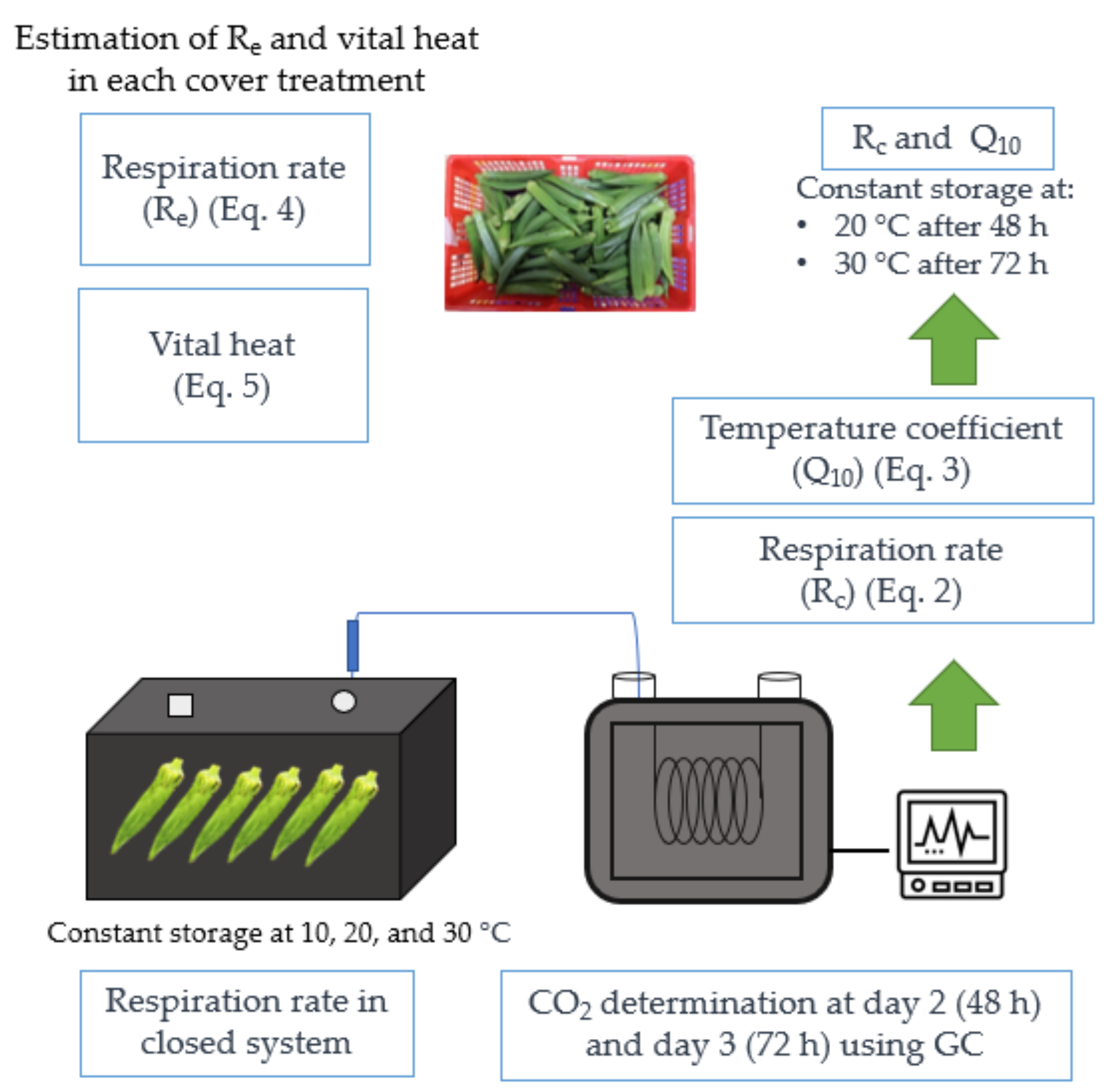

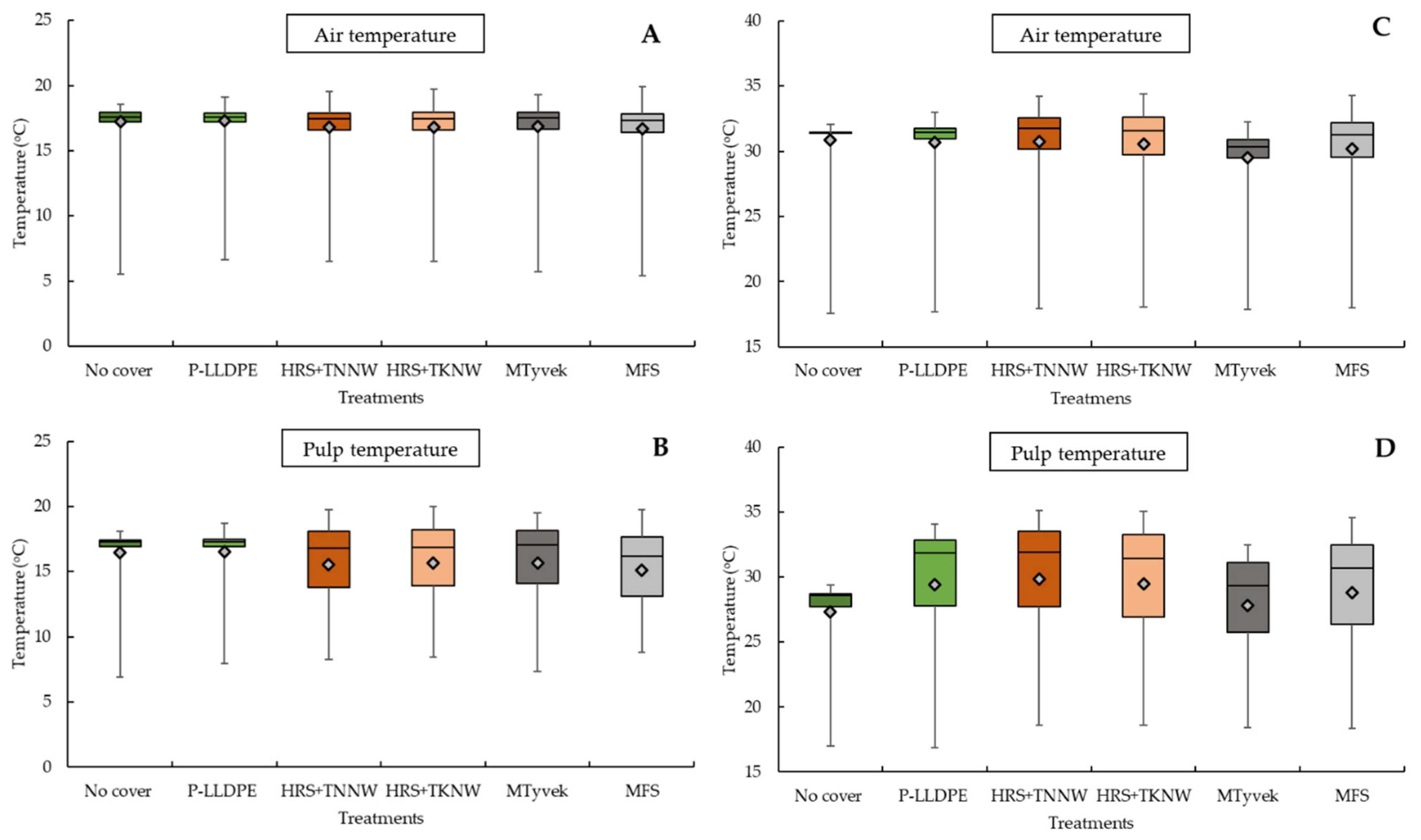
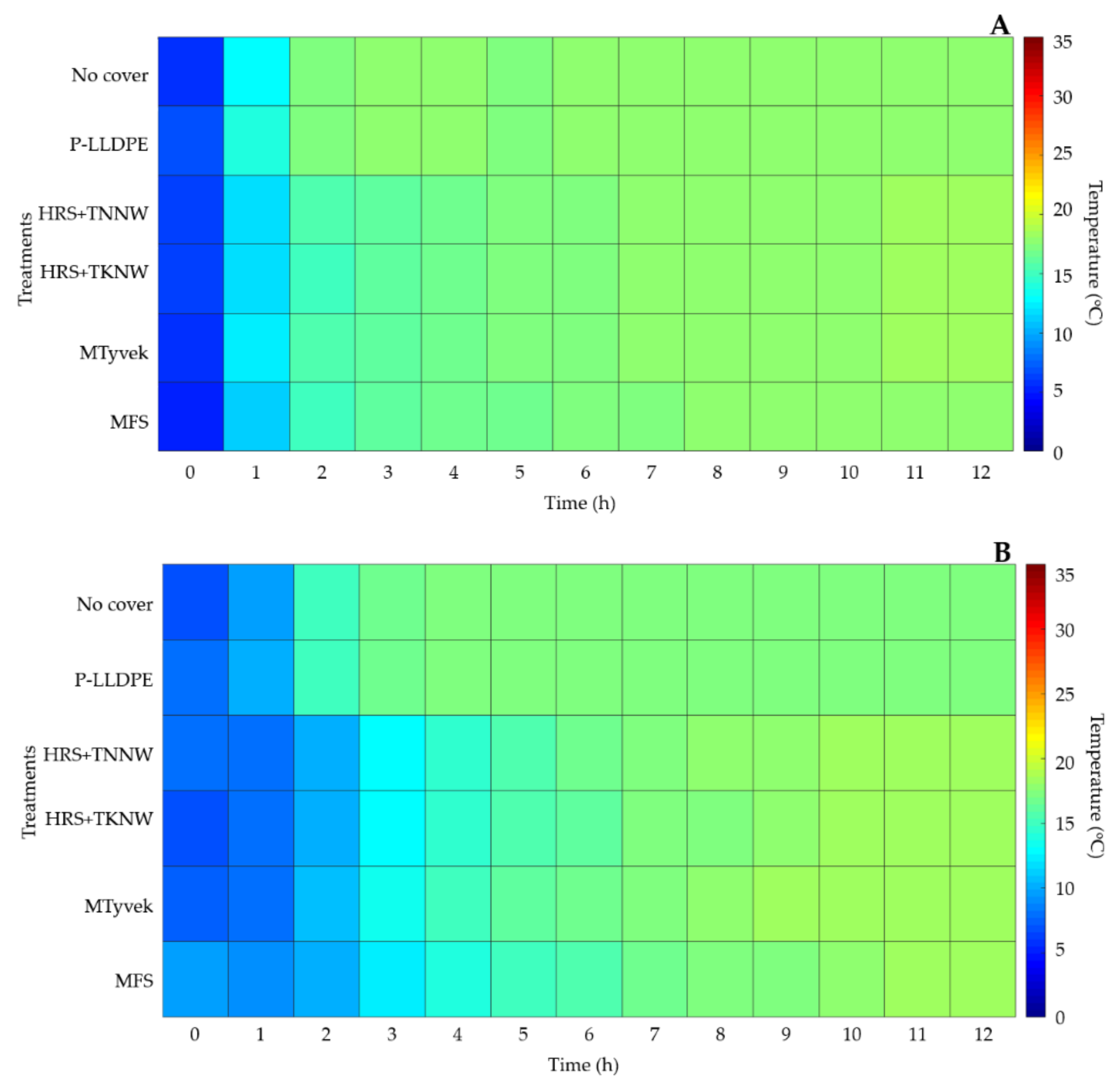

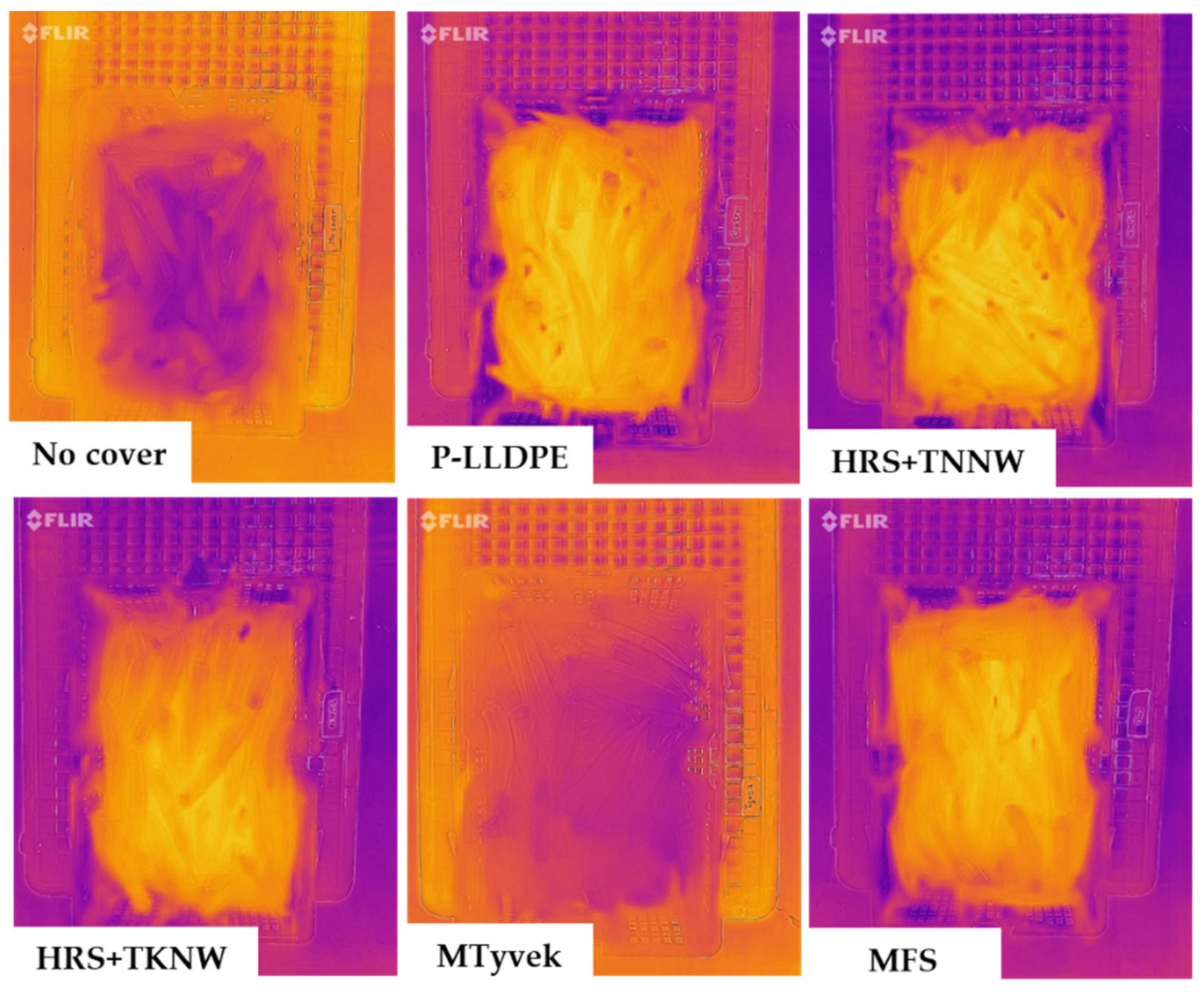
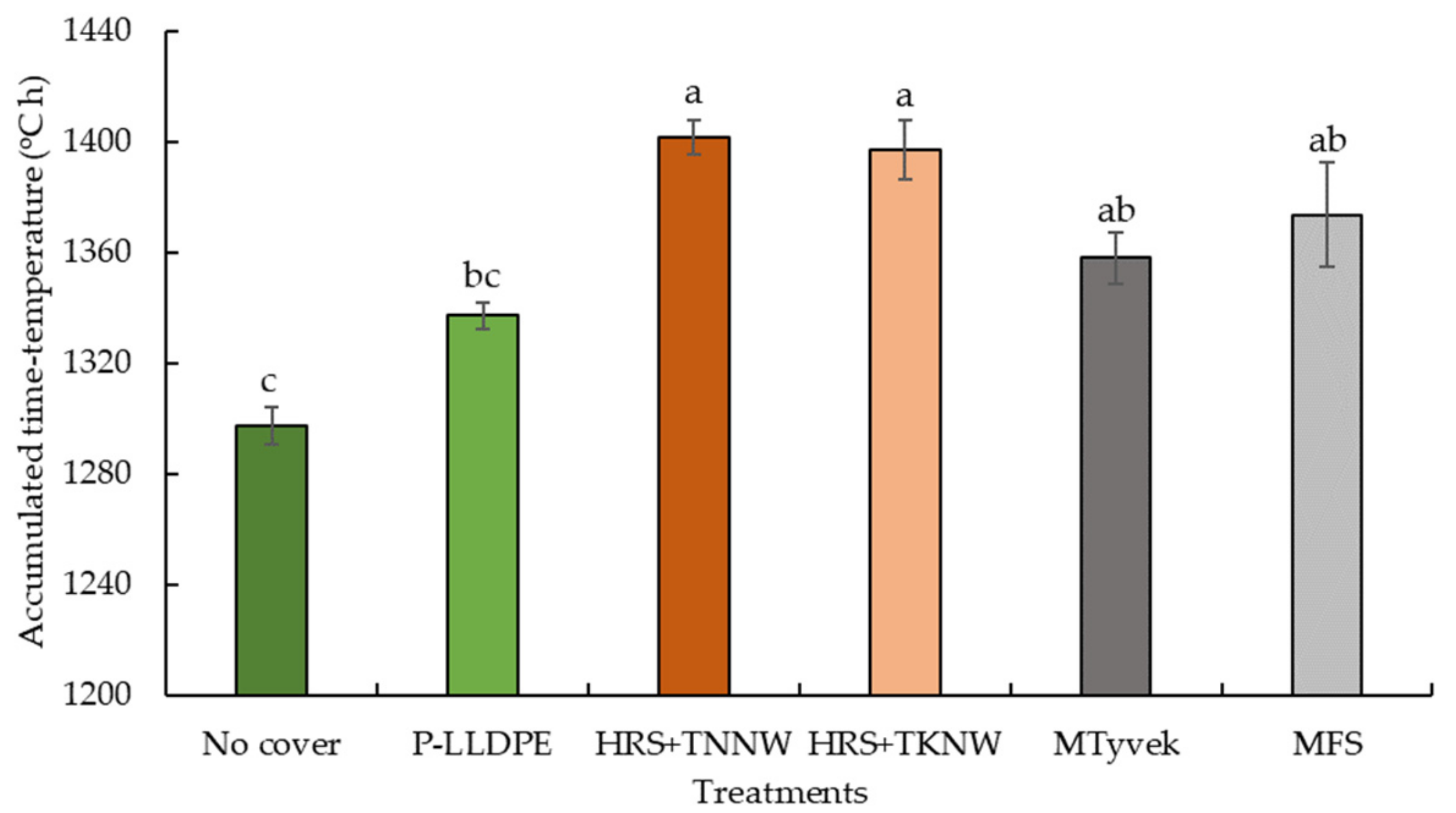
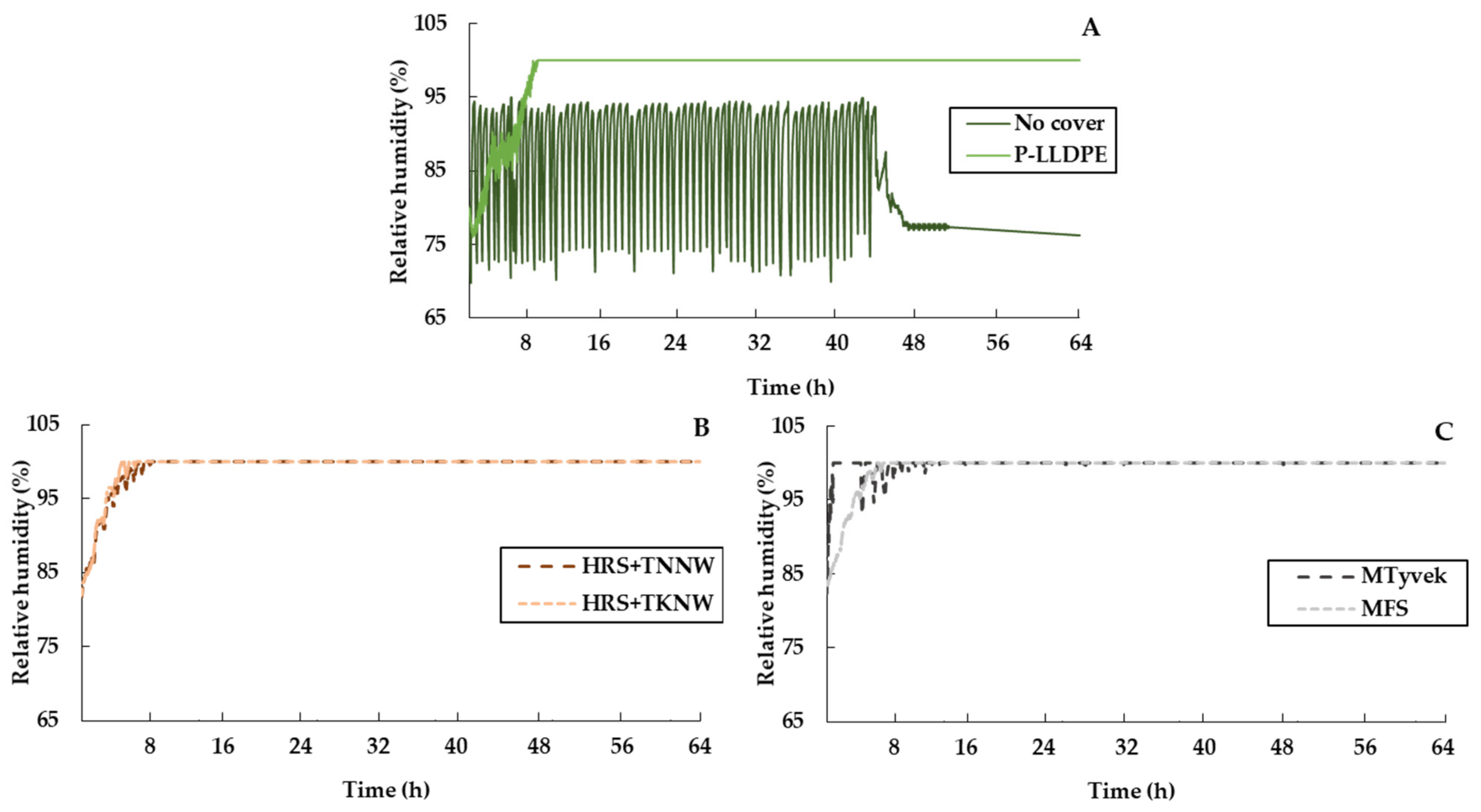
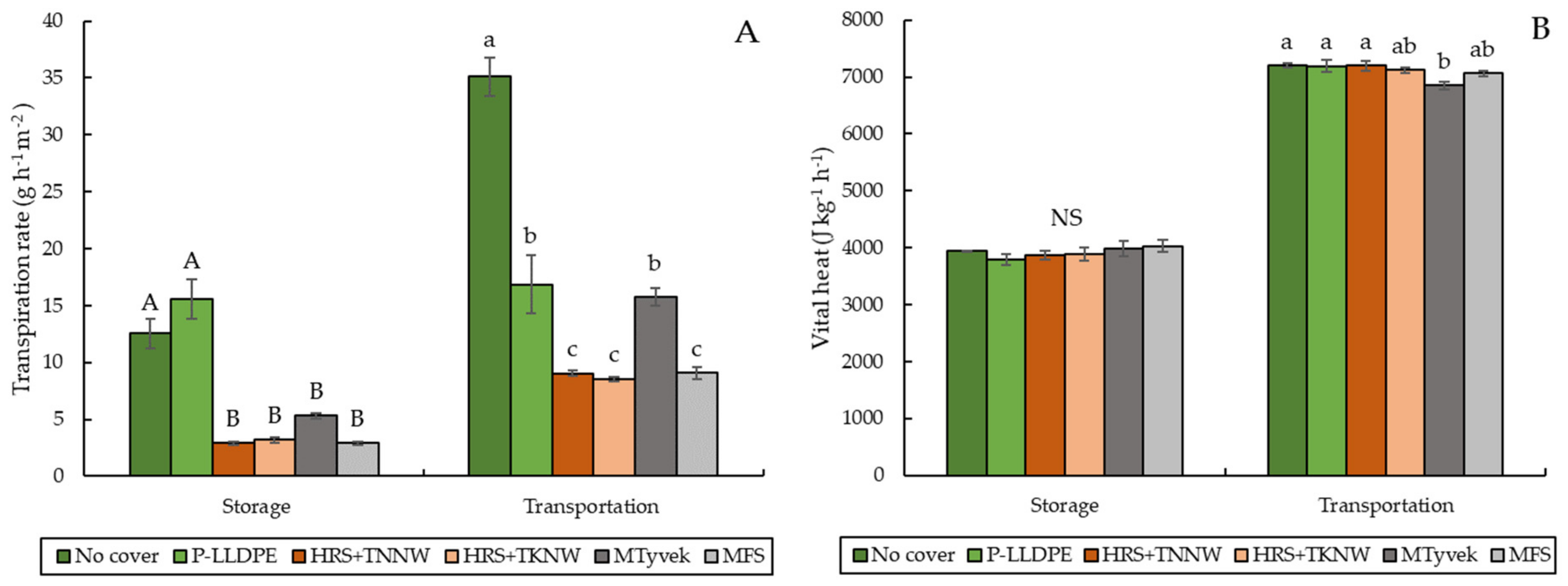
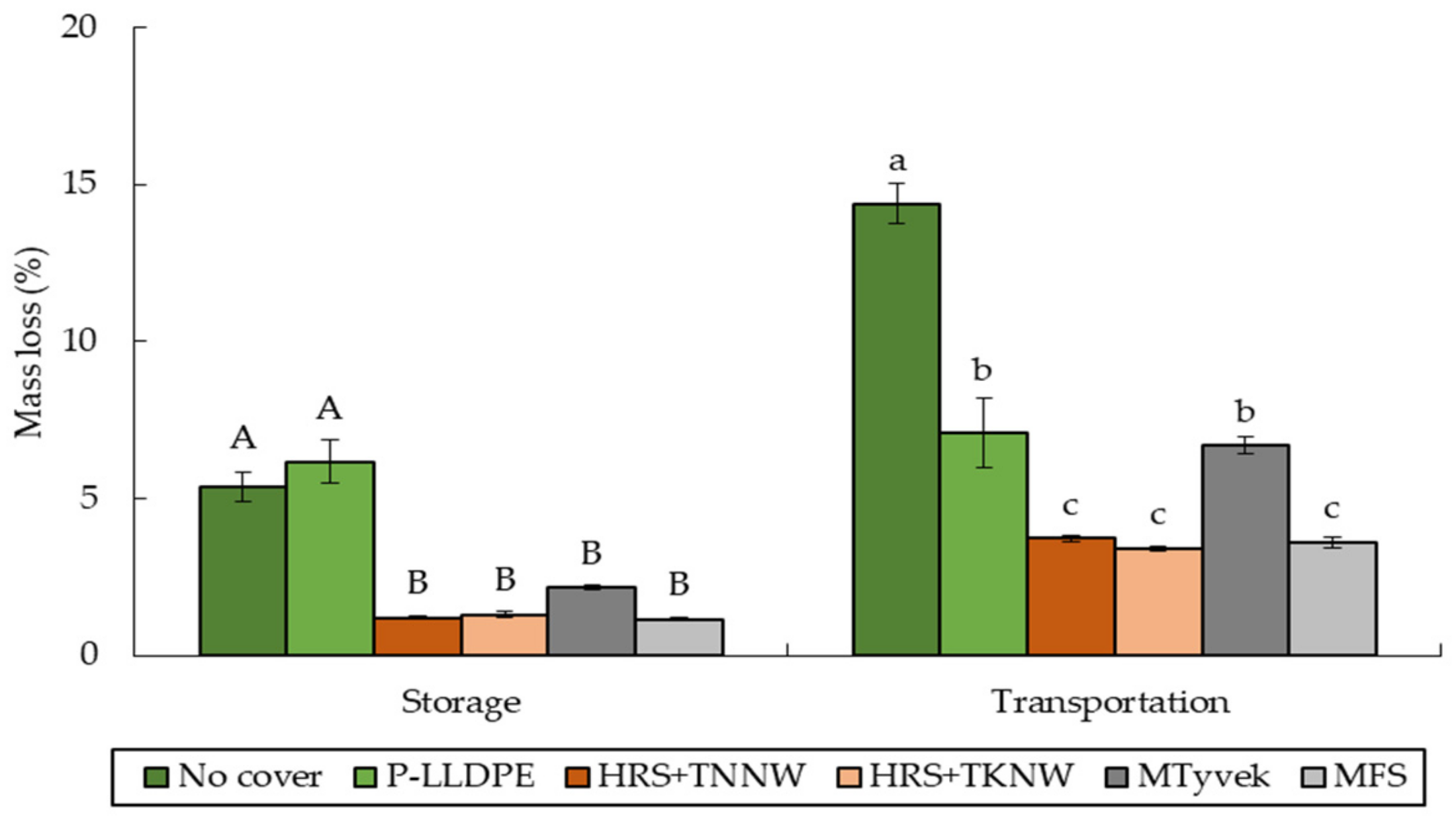
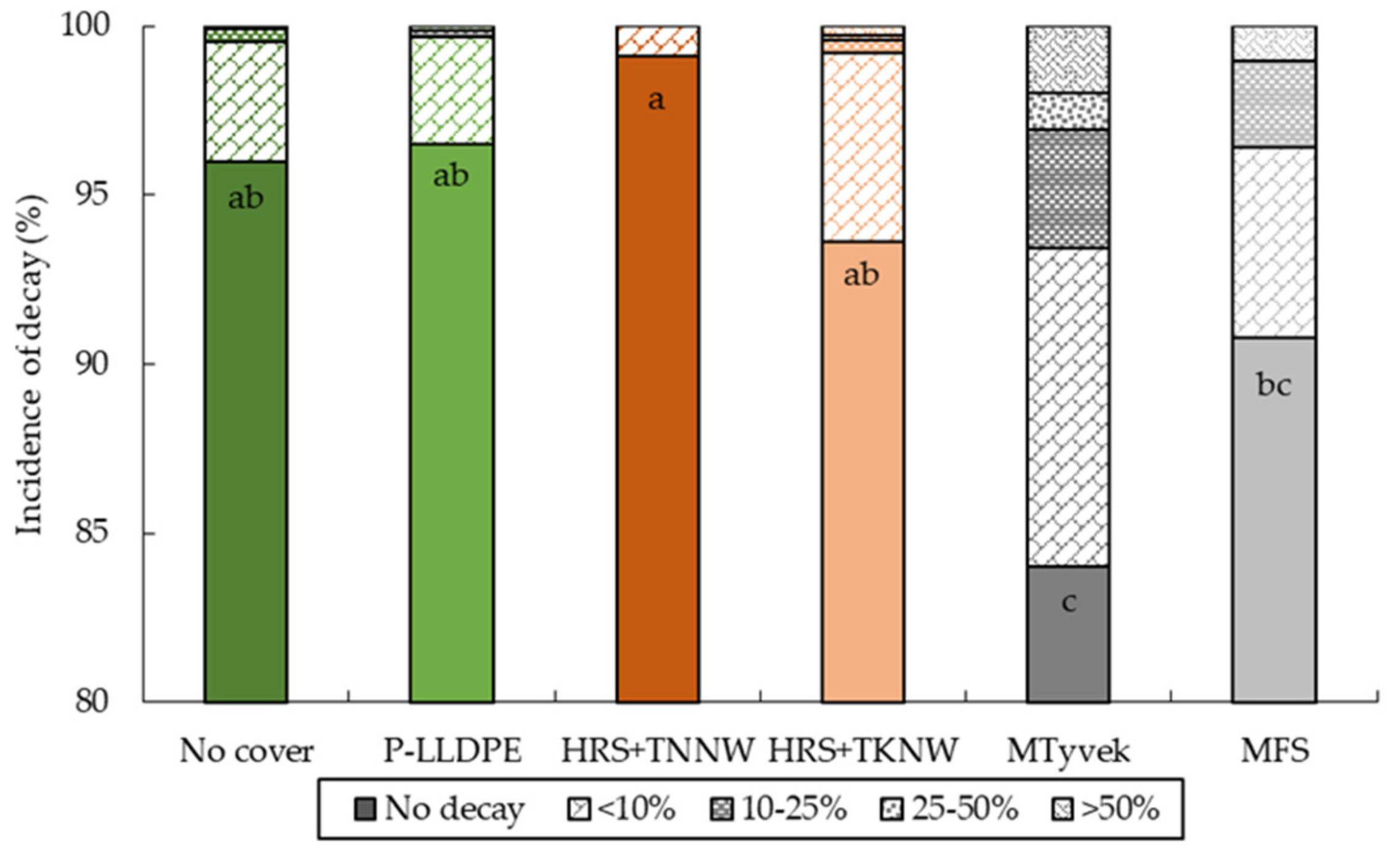

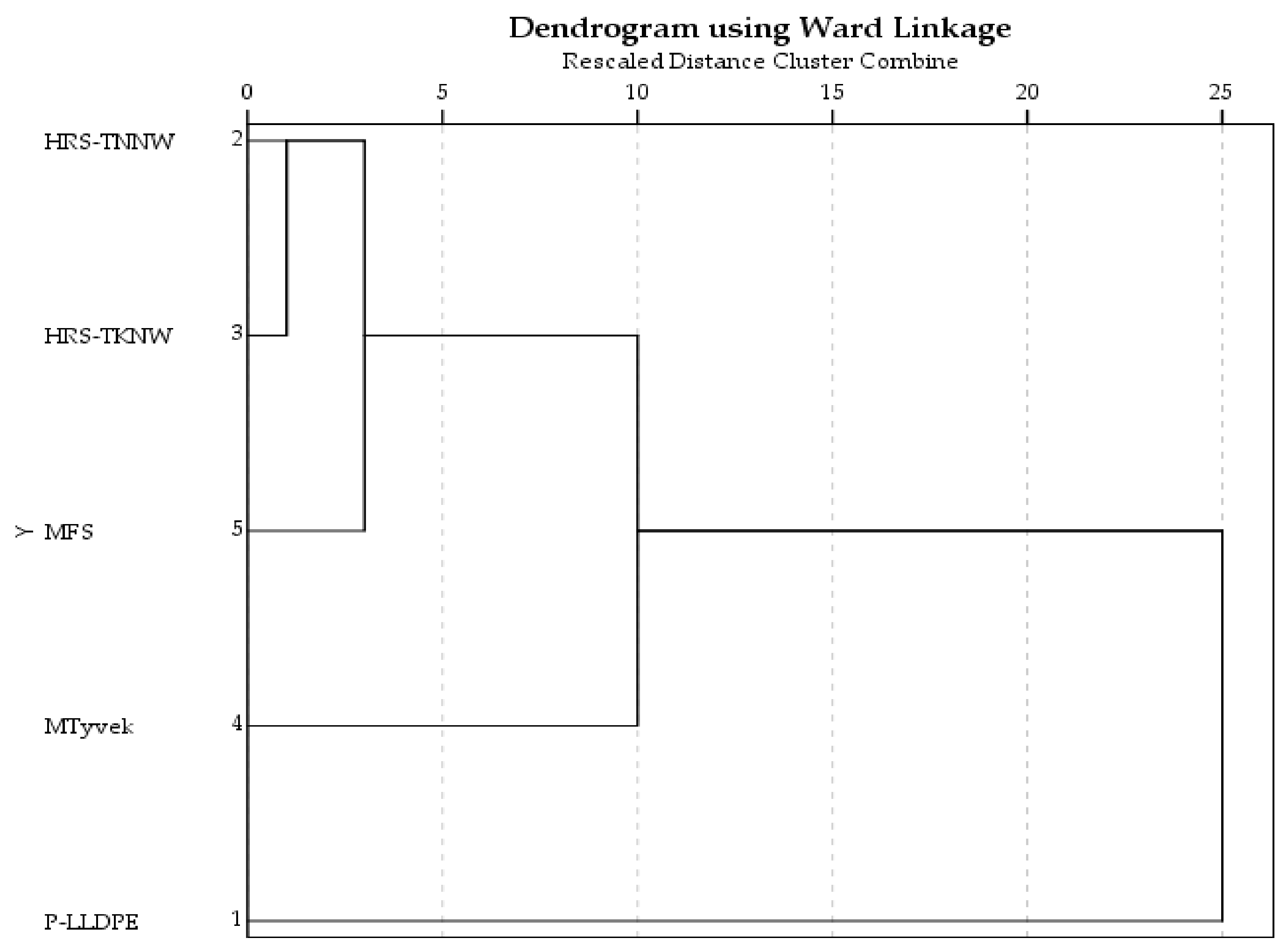
| Temperature (°C) | Rc (mg CO2 kg−1 h−1) | Q10 | ||
|---|---|---|---|---|
| Day 2 | Day 3 | Day 2 | Day 3 | |
| 10 | 183.33 | 195.26 | ||
| 1.40 | 1.51 | |||
| 20 | 245.11 | 276.68 | ||
| 1.37 | 1.46 | |||
| 30 | 333.15 | 399.05 | ||
| Material | Thickness (mm) | Thermal Heat Energy (Qx × 10−4) (J s−1) | R-Value (m2 °C W−1) | Water Vapor Permeability (g h−1 m−2) | Air Permeability (L m−2 s−1) |
|---|---|---|---|---|---|
| P-LLDPE | 0.131 ± 0.20 e | 3.750 ± 0.07 a | 0.161 ± 0.00 d | 0.360 ± 0.03 a | 172.801 ± 5.85 b |
| TNNW | 0.282 ± 0.10 d | 3.255 ± 0.04 b | 0.181 ± 0.00 c | 0.373 ± 0.11 a | 917.000 ± 64.27 a |
| TKNW | 0.478 ± 0.28 c | 3.148 ± 0.00 b | 0.194 ± 0.00 c | 0.0083 ± 0.00 b | 168.623 ± 21.70 b |
| HRS | 1.445 ± 0.02 b | 2.368 ± 0.15 c | 0.214 ± 0.01 b | 0.000002 ± 0.00 d | 0.543 ± 0.07 d |
| MTyvek | 0.127 ± 0.03 e | 2.947 ± 0.02 bc | 0.208 ± 0.00 b | 0.00057 ± 0.00 c | 0.497 ± 0.03 d |
| MFS | 3.109 ± 0.01 a | 1.440 ± 0.06 d | 0.223 ± 0.01 a | 0.000008 ± 0.00 d | 45.503 ± 4.20 c |
| Treatment | Rate of Temperature Change(°C h−1) | |||
|---|---|---|---|---|
| Air Temperature | Pulp Temperature | |||
| T1 to 25 °C | 25 °C to 30 °C | T1 to 25 °C | 25 °C to 30 °C | |
| No cover | 18.94 ± 1.20 a | 14.05 ± 2.48 a | 5.38 ± 0.04 a | 3.27 ± 0.28 a*** |
| P-LLDPE | 16.11 ± 1.19 ab | 4.70 ± 0.44 b | 4.21 ± 0.24 b | 2.72 ± 0.15 ab |
| HRS + TNNW | 13.35 ± 1.94 bc | 2.66 ± 0.63 b | 3.36 ± 0.04 c | 2.50 ± 0.23 ab |
| HRS + TKNW | 11.41 ± 0.14 bc | 2.17 ± 0.38 b | 3.02 ± 0.23 cd | 2.33 ± 0.09 b |
| MTyvek | 11.15 ± 1.02 bc | 1.46 ± 0.30 b | 2.72 ± 0.05 d | 1.27 ± 0.13 c |
| MFS | 9.26 ± 0.65 c | 2.17 ± 0.51 b | 2.91 ± 0.06 cd | 1.92 ± 0.14 bc |
| Qx | WVP | R Value | TR_ Storage | TR_ Transport | VH_ Storage | VH_ Transport | RoP T1to25 | RoP T25to30 | RoA T1to25 | RoA T25to30 | ATT | ML | Decay | |
|---|---|---|---|---|---|---|---|---|---|---|---|---|---|---|
| Qx | 1.000 | |||||||||||||
| WVP | 0.674 ** | 1.000 | ||||||||||||
| R_value | −0.925 ** | −0.791 ** | 1.000 | |||||||||||
| TR_ storage | 0.743 ** | 0.723 ** | −0.874 ** | 1.000 | ||||||||||
| TR_ transport | 0.679 ** | 0.549 * | −0.720 ** | 0.911 ** | 1.000 | |||||||||
| VH_ storage | −0.361 | −0.407 | 0.408 | −0.283 | −0.175 | 1.000 | ||||||||
| VH_ transport | 0.205 | 0.406 | −0.441 | 0.203 | −0.089 | −0.102 | 1.000 | |||||||
| RoP T1to25 | 0.659 ** | 0.849 ** | −0.851 ** | 0.819 ** | 0.625 * | −0.278 | 0.578 * | 1.000 | ||||||
| RoP T25to30 | 0.287 | 0.519 * | −0.503 | 0.340 | −0.046 | −0.214 | 0.781 ** | 0.651 ** | 1.000 | |||||
| RoA T1to25 | 0.743 ** | 0.745 ** | −0.816 ** | 0.692 ** | 0.543 * | −0.524 * | 0.343 | 0.647 ** | 0.364 | 1.000 | ||||
| RoA T25to30 | 0.514 * | 0.695 ** | −0.760 ** | 0.712 ** | 0.518 * | −0.402 | 0.721 ** | 0.854 ** | 0.624 * | 0.635 * | 1.000 | |||
| ATT | −0.655 ** | −0.310 | 0.605 * | −0.770 ** | −0.922 ** | 0.104 | 0.284 | −0.414 | 0.210 | −0.416 | −0.294 | 1.000 | ||
| ML | 0.702 ** | 0.537 * | −0.729 ** | 0.898 ** | 0.995 ** | −0.164 | −0.088 | 0.633 * | −0.052 | 0.532 * | 0.506 | −0.939 ** | 1.000 | |
| Decay | −0.271 | −0.682 ** | 0.449 | −0.216 | 0.128 | 0.289 | −0.744 ** | −0.622 * | −0.823 ** | −0.488 | −0.525 * | −0.365 | 0.132 | 1.000 |
Publisher’s Note: MDPI stays neutral with regard to jurisdictional claims in published maps and institutional affiliations. |
© 2021 by the authors. Licensee MDPI, Basel, Switzerland. This article is an open access article distributed under the terms and conditions of the Creative Commons Attribution (CC BY) license (https://creativecommons.org/licenses/by/4.0/).
Share and Cite
Rattanakaran, J.; Saengrayap, R.; Aunsri, N.; Padee, S.; Prahsarn, C.; Kitazawa, H.; Bishop, C.F.H.; Chaiwong, S. Performance of Thermal Insulation Covering Materials to Reduce Postharvest Losses in Okra. Horticulturae 2021, 7, 392. https://doi.org/10.3390/horticulturae7100392
Rattanakaran J, Saengrayap R, Aunsri N, Padee S, Prahsarn C, Kitazawa H, Bishop CFH, Chaiwong S. Performance of Thermal Insulation Covering Materials to Reduce Postharvest Losses in Okra. Horticulturae. 2021; 7(10):392. https://doi.org/10.3390/horticulturae7100392
Chicago/Turabian StyleRattanakaran, Jutarat, Rattapon Saengrayap, Nattapol Aunsri, Sirada Padee, Chureerat Prahsarn, Hiroaki Kitazawa, Chris F. H. Bishop, and Saowapa Chaiwong. 2021. "Performance of Thermal Insulation Covering Materials to Reduce Postharvest Losses in Okra" Horticulturae 7, no. 10: 392. https://doi.org/10.3390/horticulturae7100392
APA StyleRattanakaran, J., Saengrayap, R., Aunsri, N., Padee, S., Prahsarn, C., Kitazawa, H., Bishop, C. F. H., & Chaiwong, S. (2021). Performance of Thermal Insulation Covering Materials to Reduce Postharvest Losses in Okra. Horticulturae, 7(10), 392. https://doi.org/10.3390/horticulturae7100392









